Tristan Thompson
Human Anatomy and Physiology 1
November 21, 2023
Steam Project
The goal of my STEAM project is to identify and describe the four main lobes within the brain and also discuss the effects that Alzheimer’s disease has on degenerating the central nervous system and sections of the brain. I chose to cover this topic since I have had multiple family members that have been affected by this disease and I wanted to gain a greater understanding of what is occurring in the brain.
The cerebrum and cerebral cortex:
The cerebrum makes up the entire front structure of the brain and it is composed of a wrinkly grey matter covering named the cerebral cortex, with the internal material being made up of white matter. The cerebral cortex is divided into two distinct hemispheres. They are both covered with ridges called gyri and folds called sulci. The two cerebral hemispheres of the brain are joined at a deep sulcus known as the longitudinal fissure, which runs down the middle of the brain from the front to back. The right hemisphere is used to control the left side of the body while the left hemisphere is used to control the right side of the body. The two cerebral hemispheres communicate with each other through a structure that is made up of white matter and nerve pathways called the corpus callosum. Under the cerebral cortex, the cerebrum is then divided into four main structures that are classified as lobes. These lobes are named for the bone of the cranium that they are associated with. The frontal lobe is the largest lobe in the brain and it is found directly beneath the frontal bone behind the forehead. The parietal lobe is situated directly beneath the parietal bone. The occipital lobe is positioned beneath the occipital bone, and the temporal lobe, which is the second largest lobe, is located beneath the temporal bone on both sides of the head. Each section of the brain has specific functions and duties that it carries out in unison with the other lobes to allow us to go about our every-day lives. The cerebrum is also a key part of the central nervous system. (Johns Hopkins Medicine. (2021))
Frontal lobe:
The frontal lobes of the brain generally function for cognitive activities such as, emotional and social control, reasoning, problem solving, and planning. This lobe is also responsible for voluntary muscle movements motor functions, and motor control.(Cleveland Clinic. (2022)) The frontal lobe is thought to be where higher executive functions occur within the brain and this is also where personality comes from.(Queensland Brain Institute. (2018))
Parietal lobe:
The parietal lobe is where sensory information from internal or external sources is interpreted and processed. This type of information can come in many different forms such as vibration, touch, temperature, and pressure. This lobe of the brain is extremely useful in enabling many other areas of our brain to work together allowing for sensory integration to take place in this section. Other areas of the brain process sensory information and then send it to your parietal lobe to be processed, understood then responded to.(Cleveland Clinic. (2022))
Temporal lobe:
The temporal lobe assists in many of our most useful functions. This lobe has the ability to allow us to process and interpret sounds and language. The temporal lobe also plays a role in visual recognition, emotions, memory formation and storage. Within the temporal lobe is the hippocampus and the Wernicke’s area.(Cleveland Clinic. (2022)) The hippocampus is crucial for memory processes while the Wernicke’s area is essential for understanding written and spoken language.(Javed, K., Reddy, V., Das, J. M., et al. (2023))
Occipital Lobe:
Your occipital lobe is the smallest and most posterior of the four lobes. The main function of the occipital lobe is processing visual information and visual perception that enter into the brain through the eyes and optic nerve. This lobe of the brain perceives motion, colour, objects, depth perception, and many other aspects of visual information. It plays a crucial role in allowing us to detect what is happening in our surroundings and recognize things we have seen before.(Cleveland Clinic. (2022))
Alzheimer’s:
Alzheimer’s disease is a neurodegenerative disease that affects all four lobes of the cerebrum and it is the most prevalent type of dementia. Alzheimer’s is a progressive neurological disease that is characterized by memory impairment and cognitive decline that begins to slowly affect behavior, memory, speech, visuospatial orientation, and the motor system.(DeTure, M.A., Dickson, D.W. (2019).) The cause of Alzheimer’s is linked to the buildup of beta-amyloid plaques in the cerebral cortex as well a dense conglomeration of proteins that aren’t working and functioning properly.(Breijyeh, Z., & Karaman, R. (2020)) It promotes cell degeneration, looking at the Alzheimer effected brain, there is huge loss of neurons as well as obvious amyloid plaque build-up. It has been accepted that abnormal β-sheet deposition in the central nervous system has a strong association with dementia, giving rise to the amyloid hypothesis to describe the cause of Alzheimer’s. (Breijyeh, Z., & Karaman, R. (2020))
There are multiple different stages of Alzheimer’s that progressively get worse overtime. The brain is a key part of the central nervous system, and Alzheimer’s disease has a huge impact on the function of the central nervous system for both men and women. The central nervous system consumes a significant amount of energy daily to be able to function properly and this energy requirement is produced by mitochondria. Mitochondria are crucial for ATP and amino acid production which powers the neurons of the brain. Dysfunction of this crucial structure is a defining feature found in Alzheimer’s, causing the central nervous system to decay.(Jiang, Y., & MacNeil, L. T. (2023)) Neurons are what powers the communication of central nervous system, this significant atrophy of neurons which occurs from Alzheimer’s effects the brains ability to send and receive signals in all four lobes. Neurons function by sending electrical and chemical signals along a pathway, the deteriorating central nervous system is unable to send and receive these electrical and chemical signals since the neurons which make up the communication network of this system are deteriorating more and more with time. This is what causes the memory impairment, cognitive decline and other major symptoms of Alzheimer’s disease.(DeTure, M.A., Dickson, D.W. (2019).)
In my illustrations I have included a detailed top down view of the two cerebral hemispheres(Figure 1). A labeled side view of all four lobes of the cerebrum (Figure 2). A cross section of a healthy brain showing where white matter and grey matter are located. (Figure 3). A cross section view showing the atrophy that occurs in Alzheimer affected brains(Figure 4) and finally, I have a comparison of a healthy neuron and an Alzheimer’s affected neuron(Figure 5).
Works Cited
Cleveland Clinic. (2022). Brain. Cleveland Clinic. https://my.clevelandclinic.org/health/body/22638-brain
Breijyeh, Z., & Karaman, R. (2020). Comprehensive review on Alzheimer’s disease: Causes and treatment. Molecules, 25(24), 5789. https://doi.org/10.3390/molecules25245789
DeTure, M. A., & Dickson, D. W. (2019). The neuropathological diagnosis of Alzheimer’s disease. Molecular Neurodegeneration, 14, 32. https://doi.org/10.1186/s13024-019-0333-5
Jiang, Y., & MacNeil, L. T. (2023). Simple model systems reveal conserved mechanisms of Alzheimer’s disease and related tauopathies. Molecular Neurodegeneration, 18(1), 82. https://doi.org/10.1186/s13024-023-00664-x
Johns Hopkins Medicine. (2021). Anatomy of the brain. Johns Hopkins Medicine. https://www.hopkinsmedicine.org/health/conditions-and-diseases/anatomy-of-the-brain
Javed, K., Reddy, V., Das, J. M., et al. (2023). Neuroanatomy, Wernicke Area. In StatPearls (Treasure Island, FL: StatPearls Publishing). Retrieved January, 2023, from https://www.ncbi.nlm.nih.gov/books/NBK533001/
Queensland Brain Institute. (2018). Lobes of the brain. https://qbi.uq.edu.au/brain/brain-anatomy/lobes-brain
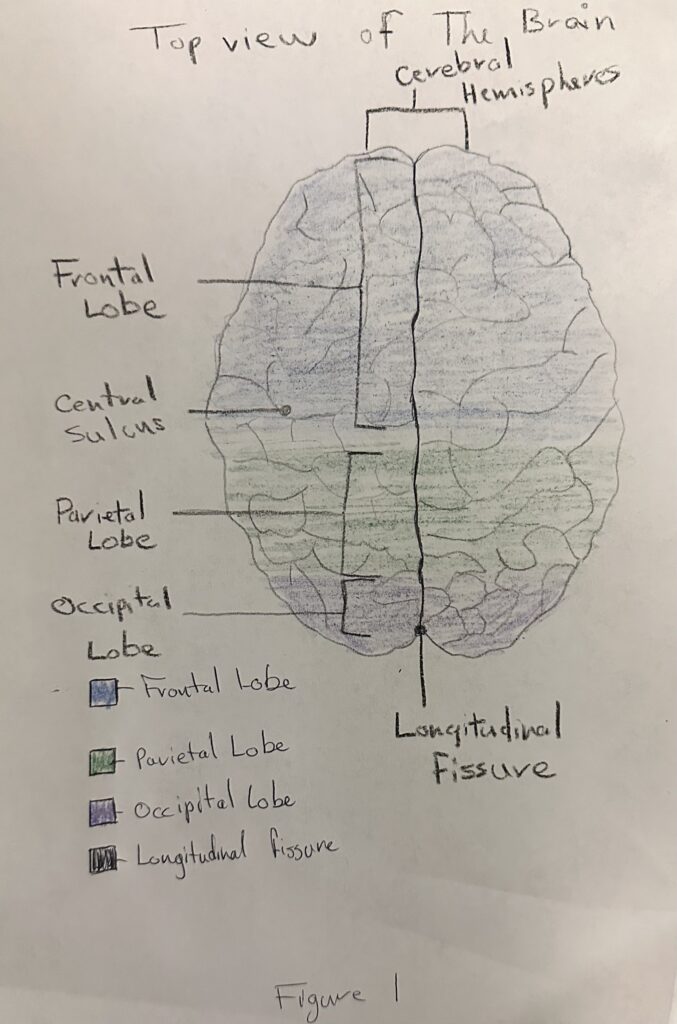
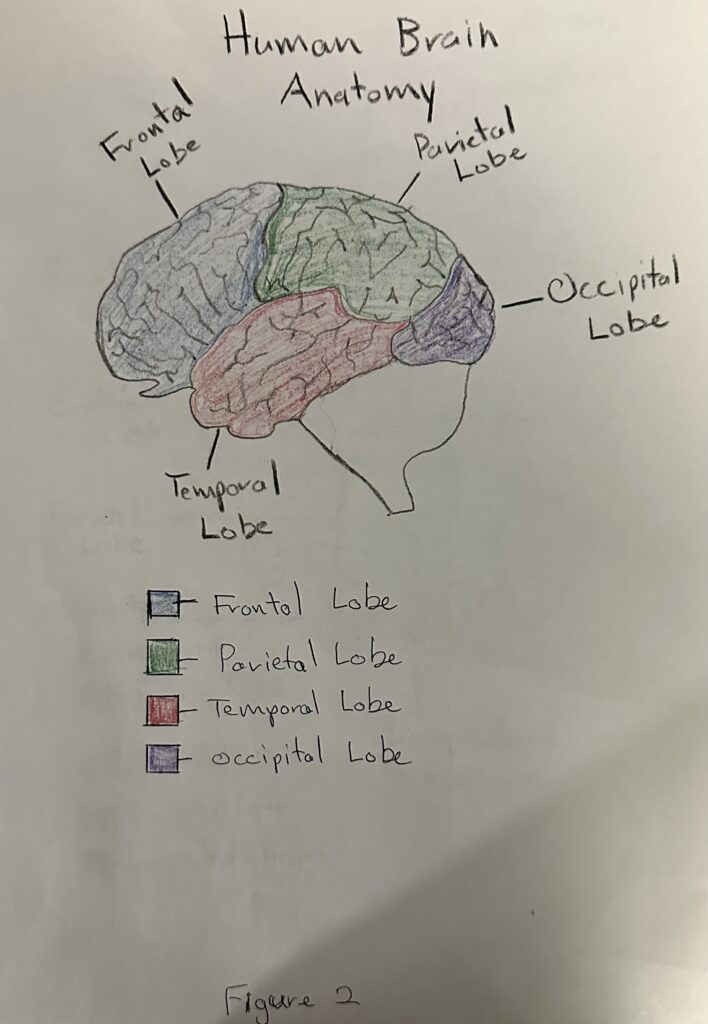
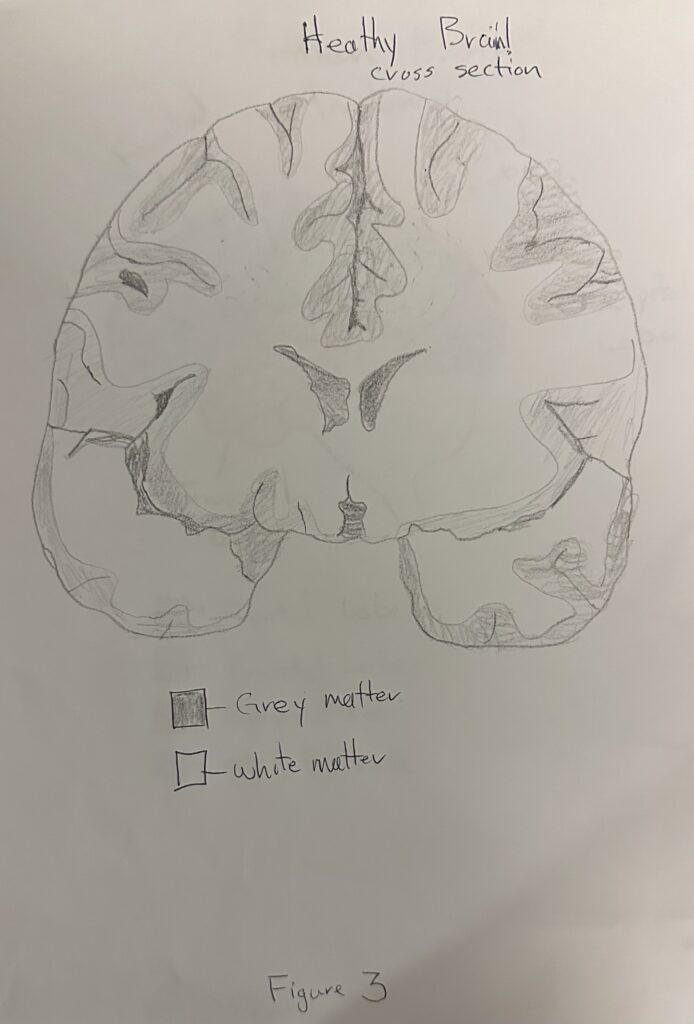
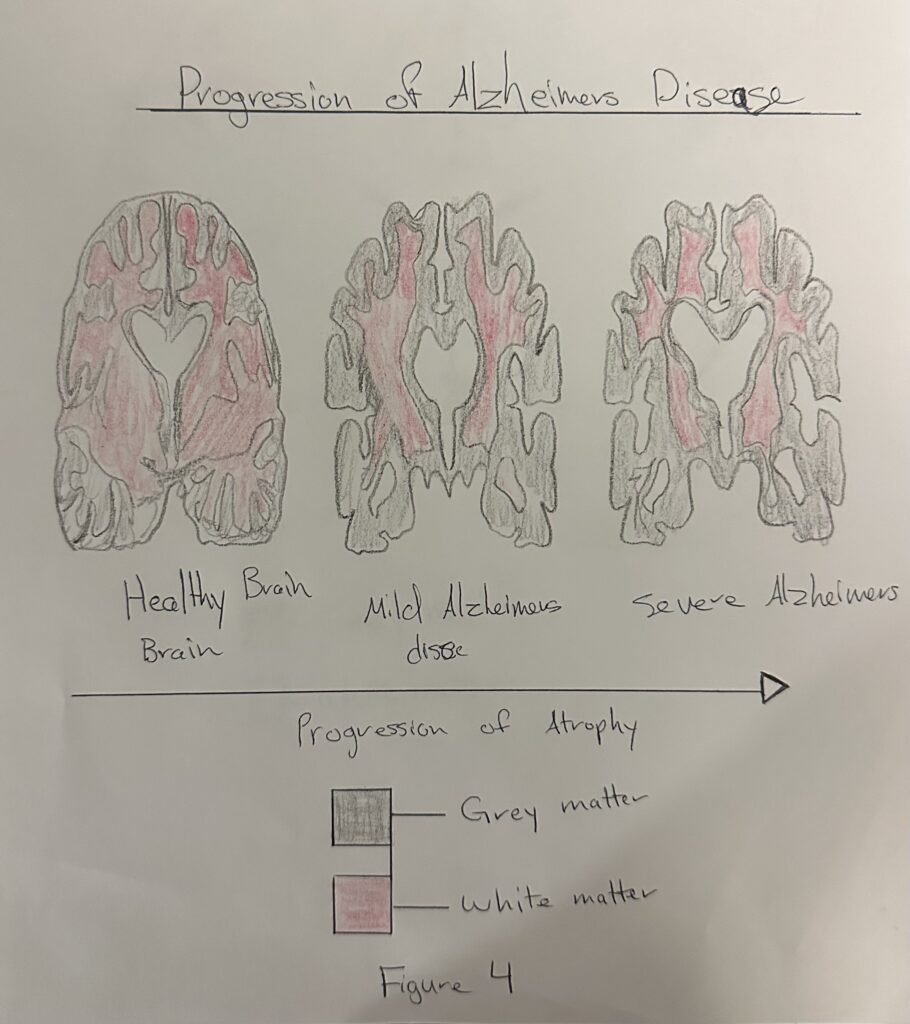
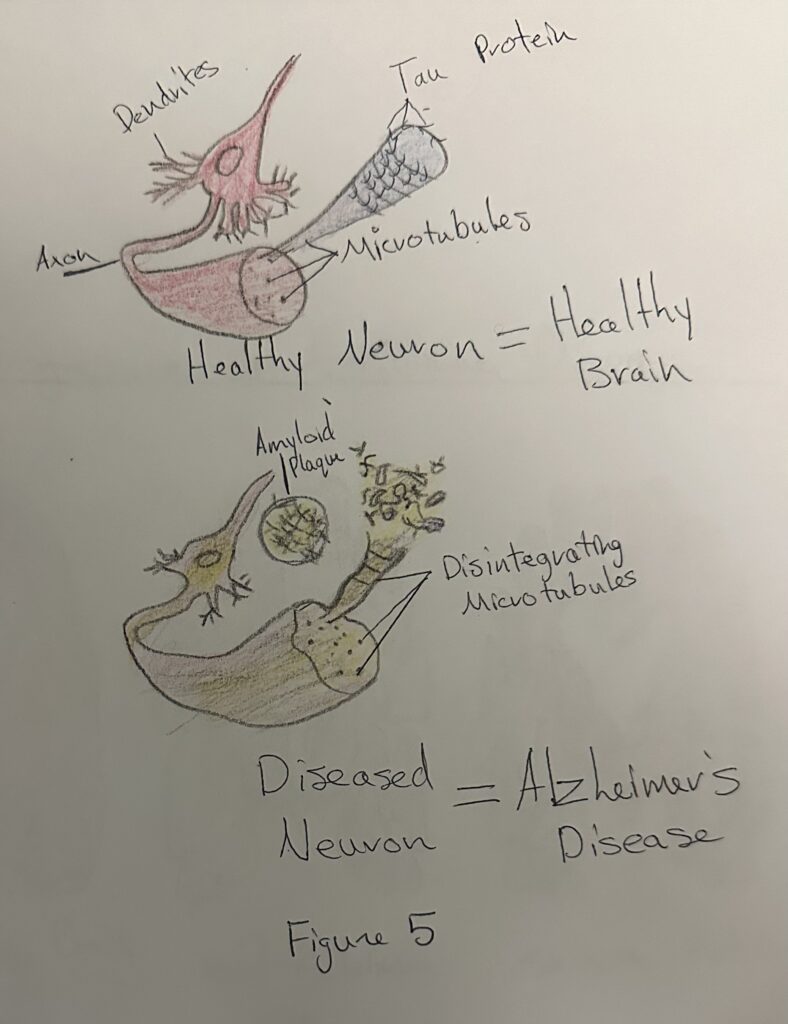
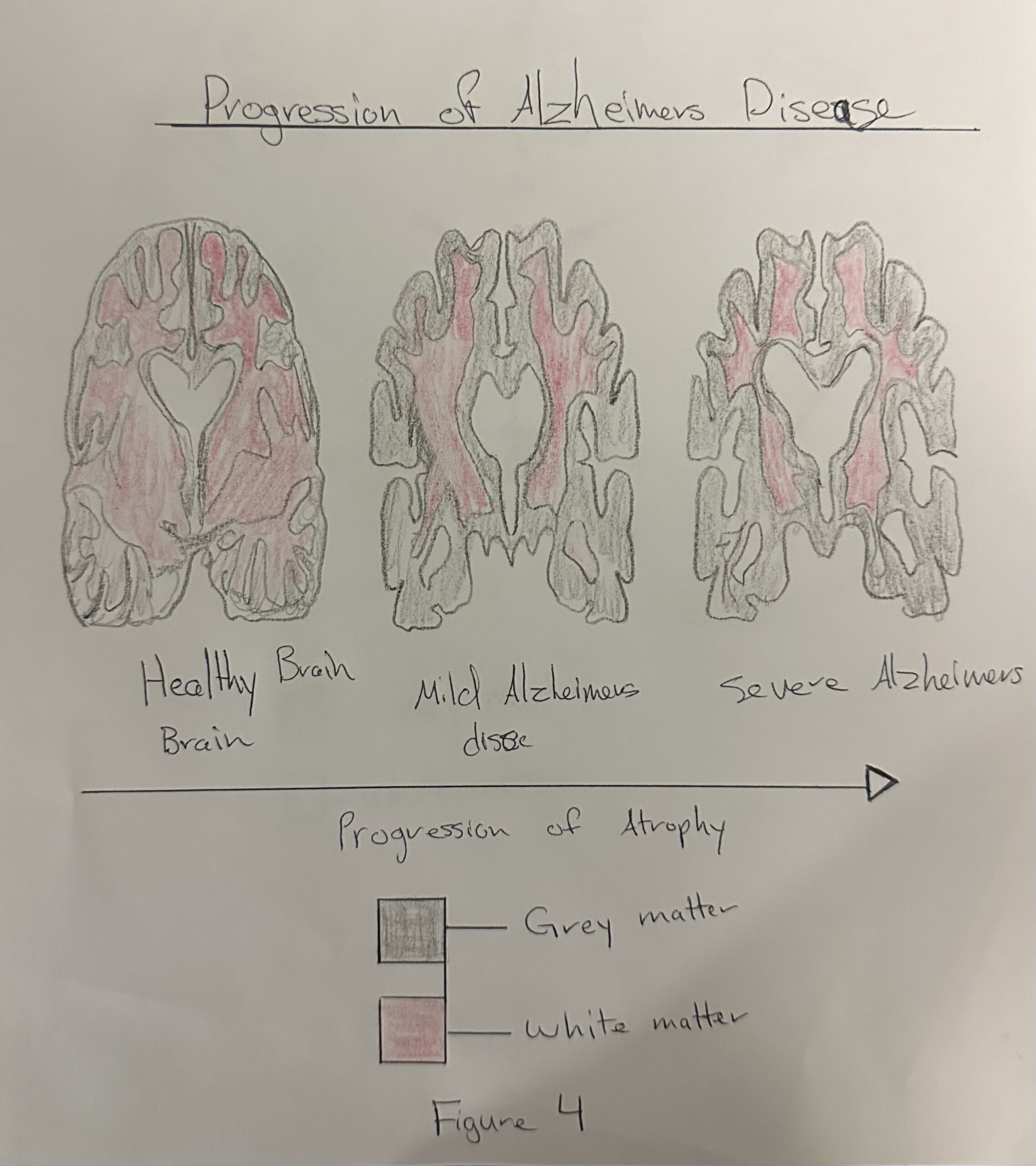
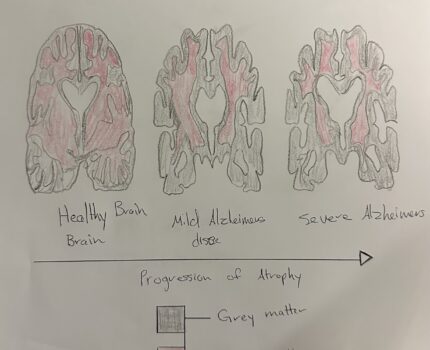
Tristan’s project identifies the main structures of the brain along with their functions, while also exploring the pathology of Alzheimer’s disease, a neurodegenerative disease that affects the entire cerebrum. Being the most common form of dementia, Alzheimer’s comes on as a progressive neurological deterioration marked by cognitive decline and memory impairment. As cognition and memory decline, so will the functions of the different structures within the cerebrum. With our four brain lobes being contained within the cerebrum, namely the parietal, temporal, occipital, and frontal lobes, a patient is likely to suffer from a loss in behavior, memory, speech, visuospatial orientation, and motor system skills.
The primary etiological factor in Alzheimer’s disease is the accumulation of beta-amyloid plaques in the cerebral cortex, as well as the effects various malfunctioning proteins have on the brain. The amyloid hypothesis posits that abnormal β-sheet deposition in the CNS gives rise to dementia and thus the symptoms of Alzheimer’s disease.
Unfortunately, Alzheimer’s will progressively get worse in stages. Namely, as it progresses, Alzheimer’s exerts a profound effect on energy production. Mitochondria, our critical energy producers, become dysfunctional, contributing to the decline of the CNS. After all, without energy, we can’t function. Neuronal atrophy begins to impair the body’s communication network, culminating in memory impairment and cognitive decline. And with this decrease in communication, so too will the CNS degrade, and thus is the cycle of Alzheimer’s disease.